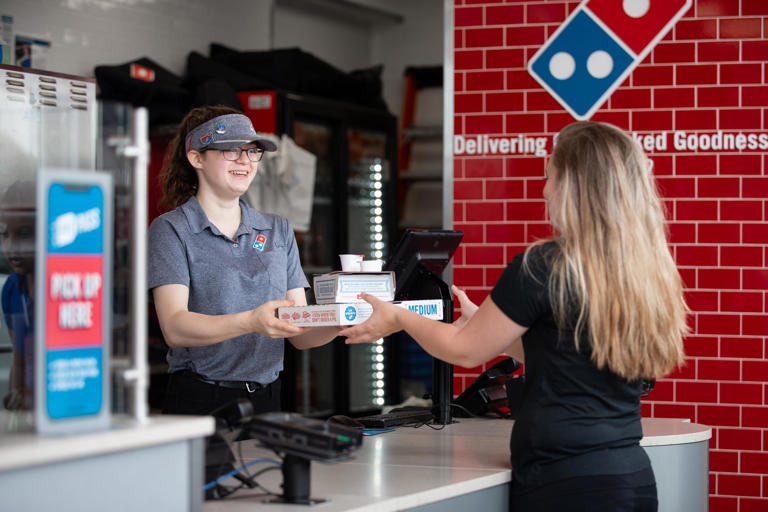Companies like DoorDash and Uber Eats have spent years building delivery services, revolutionizing how people receive their meals. However, Domino’s Pizza is experiencing a notable surge in carryout orders, according to CEO Russell Weiner. This shift highlights a distinct preference among customers who prioritize convenience and cost savings differently when it comes to food delivery and carryout.
“Our carryout business is on fire,” Weiner told Business Insider in a recent interview. “This is something we didn’t even contemplate years ago.” During Domino’s second quarter, carryout comparable sales grew by an impressive 7.9%, outpacing delivery comparable sales, which rose by 2.7%. This indicates a significant trend towards customers preferring to pick up their orders themselves.
Weiner explained that customers who opt for delivery and those who choose carryout are largely different groups with varied priorities. Delivery is primarily about convenience, with customers willing to pay extra fees and tips for the service. Domino’s operates its own delivery service and also offers delivery through Uber, which accounts for roughly 3% of Domino’s sales. Despite this, there is minimal overlap—only about 15%—between the carryout and delivery customer bases.
The pandemic saw a boom in delivery services as people stayed home and relied on companies like DoorDash, Instacart, Uber Eats, and Walmart Spark for everything from meals to electronics. However, as society reopened and prices for consumer goods, especially food, soared, many customers began cutting back on delivery due to the high costs associated with the convenience. An Instacart customer even posted on TikTok about spending nearly $100 in markups on groceries, excluding delivery fees and tips, highlighting the significant premium on delivery services.
For many budget-conscious consumers, carryout offers a cost-effective alternative. They realize that the money saved on delivery fees and tips can be significant, enough to afford additional items like another pizza. Delivery, Weiner noted, is an “expensive convenience” for many U.S. consumers.
Control is another factor driving the popularity of carryout. Many customers prefer picking up their orders themselves to ensure accuracy and timeliness, especially for events like parties. “This person’s like, ‘I don’t care if it’s out of my way, I’m going to pick it up because it’s going to be right,'” Weiner said, emphasizing the different mindset of carryout customers.
Domino’s has also made strategic moves to attract more carryout customers by opening more restaurants, reducing the distance customers need to drive. “They don’t want to drive past three or four pizza places,” Weiner said. “They’re going to the first one.” This strategy has made picking up orders more convenient and appealing to a broader customer base.
The shift towards carryout at Domino’s reflects broader changes in consumer behavior and preferences in the food industry. As delivery services continue to evolve, the balance between convenience, cost, and control will likely shape the future of how customers choose to receive their meals.
Domino’s success in attracting carryout customers is not just a matter of proximity and convenience; it also hinges on understanding the nuanced preferences of different customer segments. Weiner highlighted that the carryout and delivery customer bases are driven by distinct motivations. Delivery customers prioritize convenience and are willing to pay for it, appreciating the luxury of having food brought to their doorstep. These customers often value time and convenience over cost, making delivery a viable option despite its higher expense.
Conversely, carryout customers are more budget-conscious and value control over their orders. They prefer the assurance that comes with picking up their food themselves, reducing the risk of errors or delays that can occur with delivery. This customer segment is also sensitive to the additional costs associated with delivery, such as fees and tips, which can significantly increase the overall expense of a meal.
The resurgence in carryout orders is also a response to the broader economic context. With inflation driving up prices for many goods and services, consumers are more mindful of their spending. The appeal of saving money by avoiding delivery fees and tips is strong, especially when budgets are stretched thin. This economic reality has prompted many to reassess their spending habits, opting for more cost-effective options like carryout.
Moreover, the psychological aspect of control plays a significant role in the preference for carryout. Customers who choose to pick up their orders themselves feel more in control of their dining experience. They can ensure that their food is prepared correctly and pick it up at a time that suits them, eliminating uncertainties associated with delivery. This control is particularly important for special occasions or large gatherings, where the stakes are higher, and the margin for error is smaller.
Domino’s strategic expansion of its restaurant network to facilitate carryout is a testament to its commitment to meeting customer needs. By increasing the number of locations, Domino’s reduces the inconvenience of traveling long distances to pick up orders. This move aligns with the broader trend of enhancing customer convenience, a critical factor in the highly competitive food service industry.
The broader implications of this trend extend beyond Domino’s. It signals a potential shift in the food service industry’s dynamics, where the emphasis on delivery might be balanced by a renewed focus on carryout. This shift could influence how other restaurants and food service providers strategize their operations, potentially leading to more innovations in carryout services.
In conclusion, Domino’s success in growing its carryout business highlights the evolving preferences of consumers in the post-pandemic era. As economic conditions and consumer priorities shift, the balance between convenience, cost, and control will continue to shape the food service landscape. Domino’s ability to adapt to these changes and meet the diverse needs of its customers positions it well for sustained growth in both its delivery and carryout segments.
